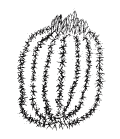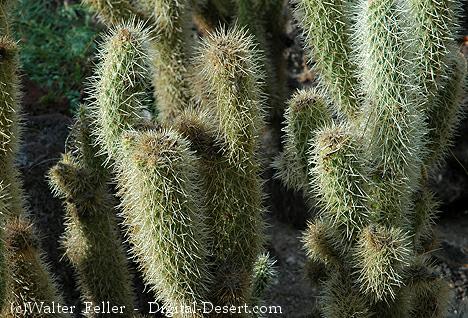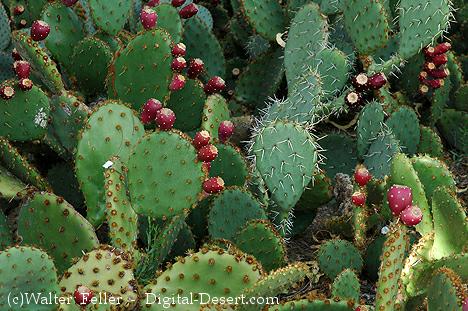Ecology of Hoover Dam
Plants of the Area
BARREL CACTUS Perhaps the most recognized cactus in Las Vegas is the
barrel cactus. It is not hollow, as many believe, but has a spongy pulp inside.
When growing, most barrel cactus lean to the South. It is also known as the
bisnaga, red barrel, fire barrel, solitary barrel and compass barrel
cactus.
Perhaps the most recognized cactus in Las Vegas is the
barrel cactus. It is not hollow, as many believe, but has a spongy pulp inside.
When growing, most barrel cactus lean to the South. It is also known as the
bisnaga, red barrel, fire barrel, solitary barrel and compass barrel
cactus.
(More abouth the Barrel Cactus)
BEAVERTAIL CACTUS This cactus has flat, greenish jointed stems with rose or
lavender flowers from March to June. The height is 6 to 12 inches and frequently
found in dry, rocky desert flats or slopes. The beavertail cactus looks like the
prickly pear, but does not have long spines. It has tiny hair-like spines
instead.
This cactus has flat, greenish jointed stems with rose or
lavender flowers from March to June. The height is 6 to 12 inches and frequently
found in dry, rocky desert flats or slopes. The beavertail cactus looks like the
prickly pear, but does not have long spines. It has tiny hair-like spines
instead.
(More abouth the Beavertail Cactus)
CHOLLA CACTUS The cholla (pronounced "cho-yah") cactus has jointed stems
that are tubular. These joints can break off and take root in the ground to grow
a whole new cholla cactus. After the plant dies, a skeleton of "ventilated wood"
remains in the desert. There are many different kinds of cholla in the Mojave
Desert.
The cholla (pronounced "cho-yah") cactus has jointed stems
that are tubular. These joints can break off and take root in the ground to grow
a whole new cholla cactus. After the plant dies, a skeleton of "ventilated wood"
remains in the desert. There are many different kinds of cholla in the Mojave
Desert.
(More abouth the Cholla Cactus)
CREOSOTE BUSH This large shrub has small, round leaves which look and feel
oily or sticky. This coating called "lac", helps to keep water from being lost
to the dry air. Indians used lac as glue. Mexicans called this plant, "little
stinker".
This large shrub has small, round leaves which look and feel
oily or sticky. This coating called "lac", helps to keep water from being lost
to the dry air. Indians used lac as glue. Mexicans called this plant, "little
stinker".
(More abouth the Creosote Bush)
DESERT MALLOW The mallow is common to roadsides and vacant lots. This
plant has orange flowers and fuzzy leaves. The star-shaped hairs may get in your
eyes if you handle the plant. That is why it is called the "sore-eye
poppy".
Photo of Desert Mallow
The mallow is common to roadsides and vacant lots. This
plant has orange flowers and fuzzy leaves. The star-shaped hairs may get in your
eyes if you handle the plant. That is why it is called the "sore-eye
poppy".
Photo of Desert Mallow
DESERT MARIGOLD This common plant has inch wide yellow flowers. These
flowers look like small sunflowers on tall stalks. The marigold's fuzzy leaves
grow at its base.
This common plant has inch wide yellow flowers. These
flowers look like small sunflowers on tall stalks. The marigold's fuzzy leaves
grow at its base.
INDIAN PAINT-BRUSH The flowers of this small colorful plant are barely visible.
A "brush" of bright orange or red surrounds the tiny flowers. The top of the
plant looks as if it has been dipped in paint.
The flowers of this small colorful plant are barely visible.
A "brush" of bright orange or red surrounds the tiny flowers. The top of the
plant looks as if it has been dipped in paint.
PRICKLY PEAR CACTUS There are many kinds of prickly pear cactus (nearly every
state has a native species). Most can be recognized by flattened stems, called
pads, that grow from joints. Indians would carefully scrape or burn off the
spines and cook the pads for food. The egg-shaped fruits, called "tunas", can
still be found in some grocery stores.
There are many kinds of prickly pear cactus (nearly every
state has a native species). Most can be recognized by flattened stems, called
pads, that grow from joints. Indians would carefully scrape or burn off the
spines and cook the pads for food. The egg-shaped fruits, called "tunas", can
still be found in some grocery stores.
(More abouth the Prickly Pear Cactus)
ROCK NETTLE This plant is found in dry, rocky places or on canyon walls
in the desert. A rounded, bushy plant with stinging hairs and flowers, blooms
from April to June. The flowers are cream or pale yellow in color. Do not pick
the flowers -- the stinging hairs are vicious!
This plant is found in dry, rocky places or on canyon walls
in the desert. A rounded, bushy plant with stinging hairs and flowers, blooms
from April to June. The flowers are cream or pale yellow in color. Do not pick
the flowers -- the stinging hairs are vicious!
SACRED DATURA This plant is unusual for the desert. The datura is vinelike
with large, grey-green leaves. The flowers look like large white trumpets,
several inches long. It is sometimes called the "moon-lily", because the flowers
open at night. This is when the Giant Sphinx Moth pollinates the flowers. It is
also known as "jimson-weed" or "thornapple" because of its round, spiny seed
pod. All parts of this plant are poisonous.
This plant is unusual for the desert. The datura is vinelike
with large, grey-green leaves. The flowers look like large white trumpets,
several inches long. It is sometimes called the "moon-lily", because the flowers
open at night. This is when the Giant Sphinx Moth pollinates the flowers. It is
also known as "jimson-weed" or "thornapple" because of its round, spiny seed
pod. All parts of this plant are poisonous.
(More abouth the Sacred Datura)

Beavertail cactus
Desert Plants

Cholla cactus

Prickly pear cactus